Odoo
Use our integration with Odoo to automatically generate invoices.
Use our integration with Odoo to automatically generate invoices.
Table of contents
Integrating your Odoo account with your CrewPlanner account
Configure the Odoo integration
Connect your companies in the company file
Connect your articles from Odoo with CrewPlanner
Connect ledger accounts with CrewPlanner
Introduction
If you use Odoo to process your invoicing, you have the option to integrate CrewPlanner with Odoo to invoice the hours worked from CrewPlanner to your clients.
You can use our invoicing module after it has been activated by your account manager. Please note that this does incur additional monthly fees.
How do you get started?
First you contact your account manager via the chat function or at [email protected] . After your account manager has activated the invoicing module, follow this article to integrate with Odoo and set up your general settings.
For more information on setting up invoicing rules in CrewPlanner and creating invoices or credit notes, see the article on the invoicing module.
Integrating your Odoo account with your CrewPlanner account
As soon as your account manager has activated the invoicing module and the link to Odoo, navigate via SETTINGS on the right to INTEGRATIONS. Here you will find the Odoo integration.
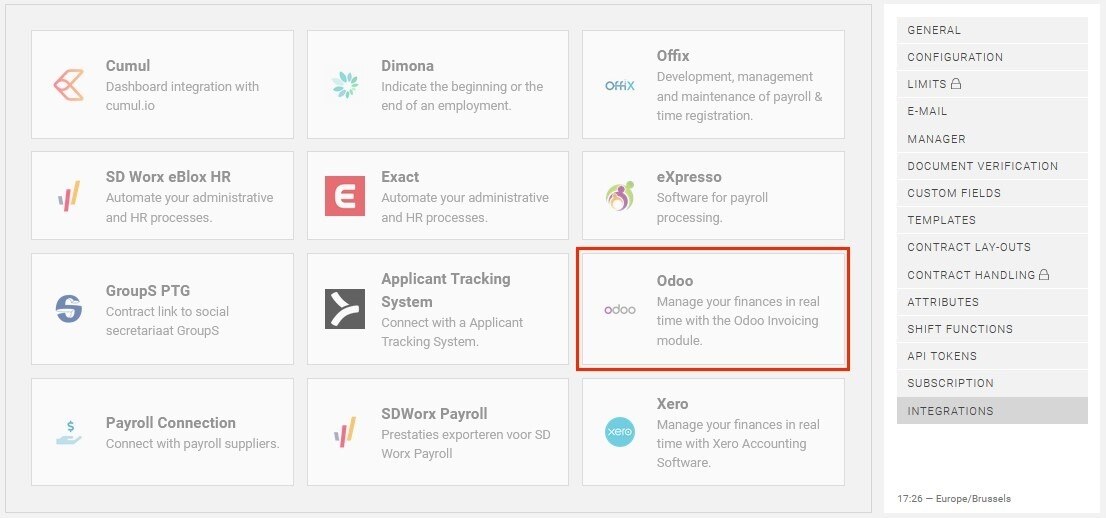
Once selected, you will be taken to the next page. Here you will see ENABLE underneath the Odoo logo, to activate the integration.
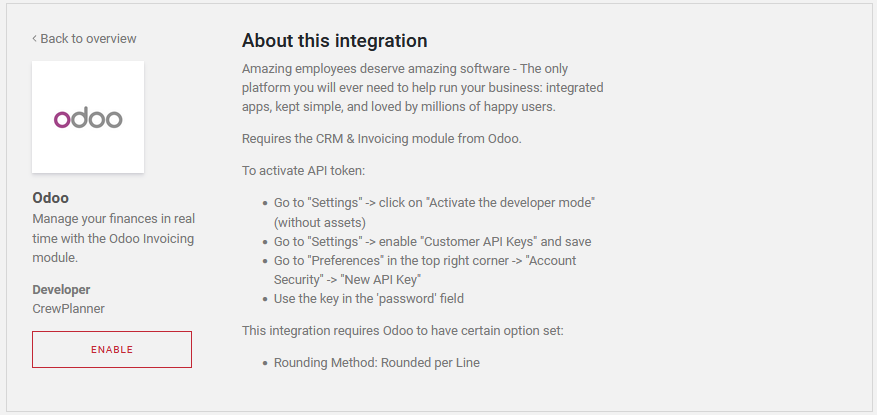
Next, you will be asked for your Odoo account details and the API token you need to generate in Odoo. For this, please follow the guidelines at the bottom of the box, but we will guide you through this in the section below.

Once you select SAVE, a green banner will appear at the top notifying you that your link is in place.
Configure the Odoo integration
Exactly which data needs to be entered on the setup page, where to find it and how to create the API token in Odoo:
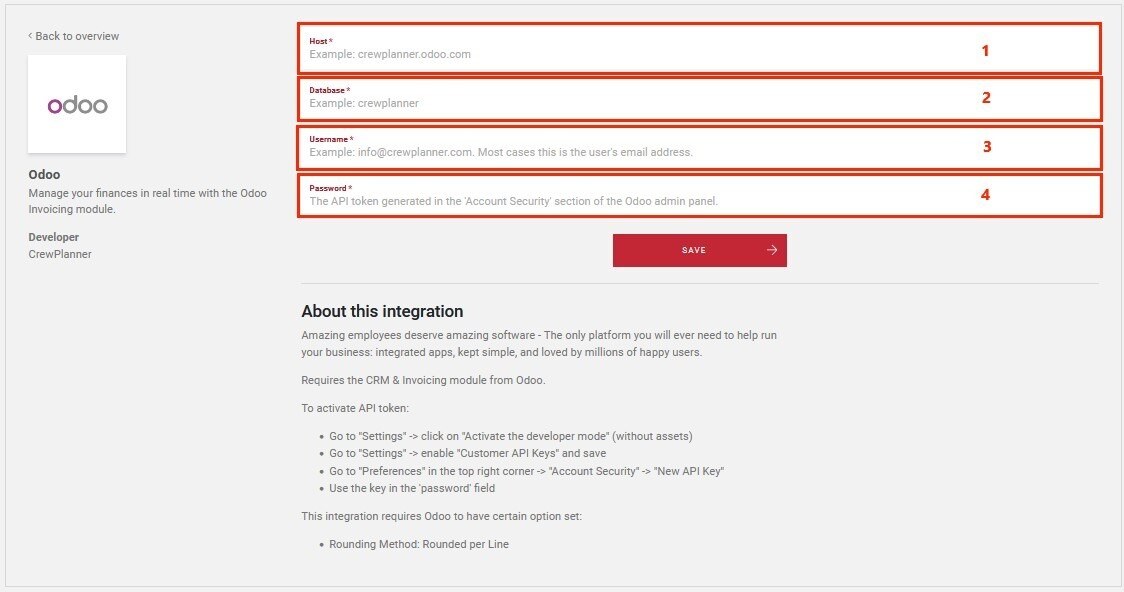
-
Host: when logged into Odoo, you will find this information in the URL address at the top of the page. Type or copy/paste here what follows after but does not include 'https://'.
-
Database: this is the first part of the host, usually the name of your company
-
Username: your username with Odoo, usually this is your email address
-
Password: this is the API token you generate in Odoo. More on this in the next chapter
Host: when logged into Odoo, you will find this information in the URL address at the top of the page. Type or copy/paste here what follows after but does not include 'https://'.
Database: this is the first part of the host, usually the name of your company
Username: your username with Odoo, usually this is your email address
Password: this is the API token you generate in Odoo. More on this in the next chapter
Generate API token in Odoo
At the bottom of the settings page, you will find brief instructions on how to generate your API token, but we will go through the necessary steps for you:
Once you have logged into Odoo, you will have the following page where you select settings:
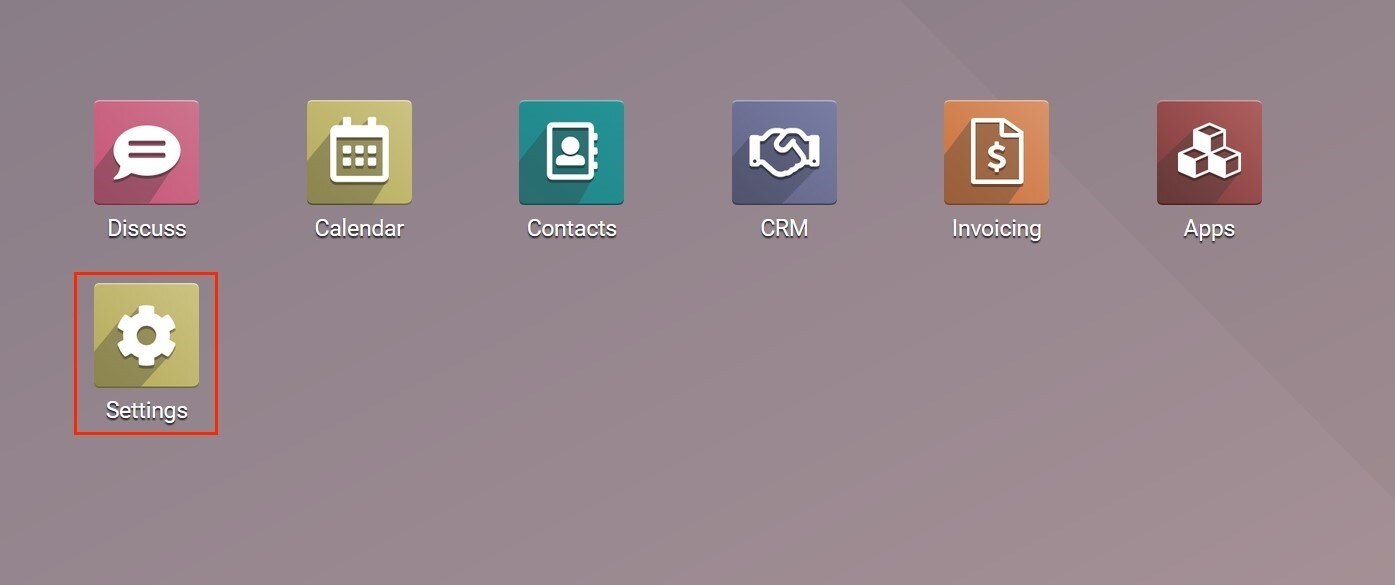
After this, the following screen opens and there you will find Activate the developer mode at the bottom.
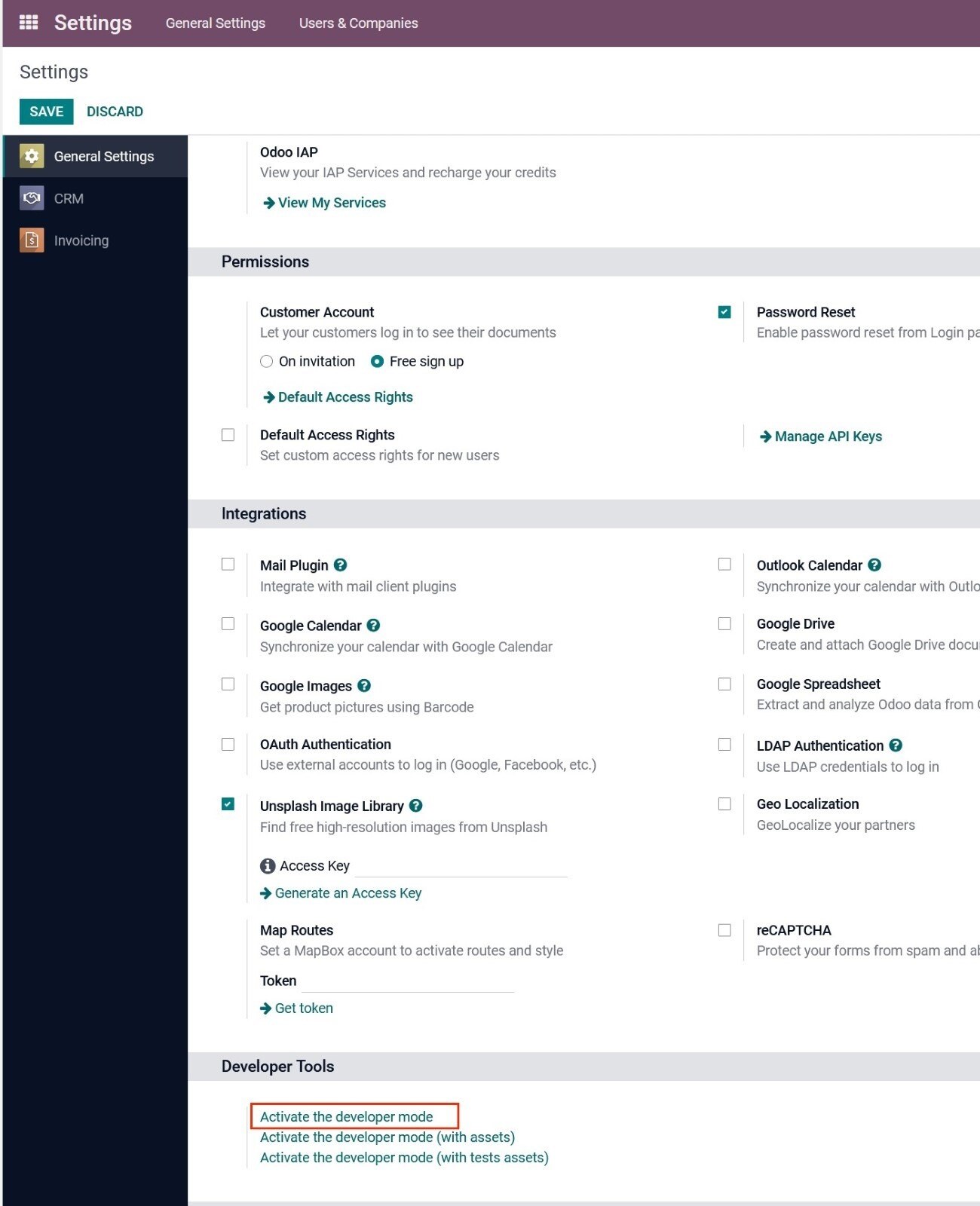
After you select this, at the top right under Manage API Keys, the option Customer API Keys appears with a checkbox next to it.

Tick this and press SAVE. If successful, you will find the following icon in the top right corner of your screen:

Next, go to your preferences and there, in the second tab Account Security, you will find NEW API KEY at the bottom.

After you select this, the next pop-up opens where you can give the API Key a name, e.g. CrewPlanner, so that you know what this API Key was generated for.

Finally, select GENERATE KEY at the bottom left which will generate the API token and you will get the following screen:

The API key or token is displayed in red. You then select and copy this text to point 4 on the CrewPlanner settings page, under password. With this information, you can complete your integration settings with Odoo and, as mentioned earlier, once you select SAVE, the connection is in place.
CrewTip! it is best to keep this API token or Key in a safe place, as you will not be able to look it up again in Odoo later.
Connect your companies in the company file
You now have the additional tab ODOO in your company file. Here the company from Odoo is displayed to which this company in CrewPlanner is linked to.

CrewPlanner automatically links a company with the first company with the same VAT number from Odoo's database, allowing information to be exchanged correctly.
CrewTip! Please note, you can only link companies with your contacts in Odoo if they are created as companies and not as individuals.
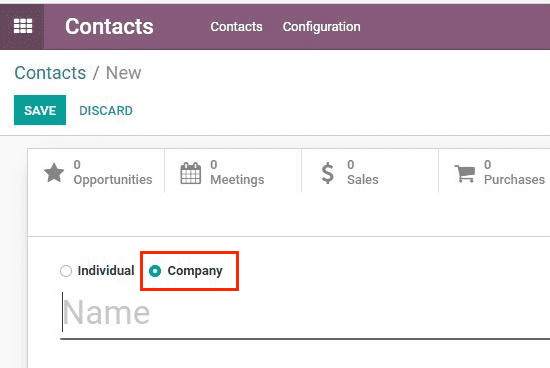
However, you can also perform or change this link manually by selecting the desired company from the dropdown menu at the top and selecting SAVE.
For example, if you want to link your company in CrewPlanner with another office of the corresponding company from Odoo's database.
Connect your articles from Odoo with CrewPlanner
In order to set up the remaining invoicing rules as accurately as possible, we move on to connecting your articles. It is important that you set this basis properly from Odoo to make optimal use of it in CrewPlanner. Here, we'll also briefly discuss which actions you need to take in Odoo.
However, if you are not quite comfortable with setting up your items in Odoo, we recommend involving your accountant.
CrewTip! you can also take advantage of our extra paid service, if necessary, where our Odoo expert will set this up for you completely in consultation with your accountant.
From the INVOICING page you now have at SETTINGS, select the last tab ARTICLES.
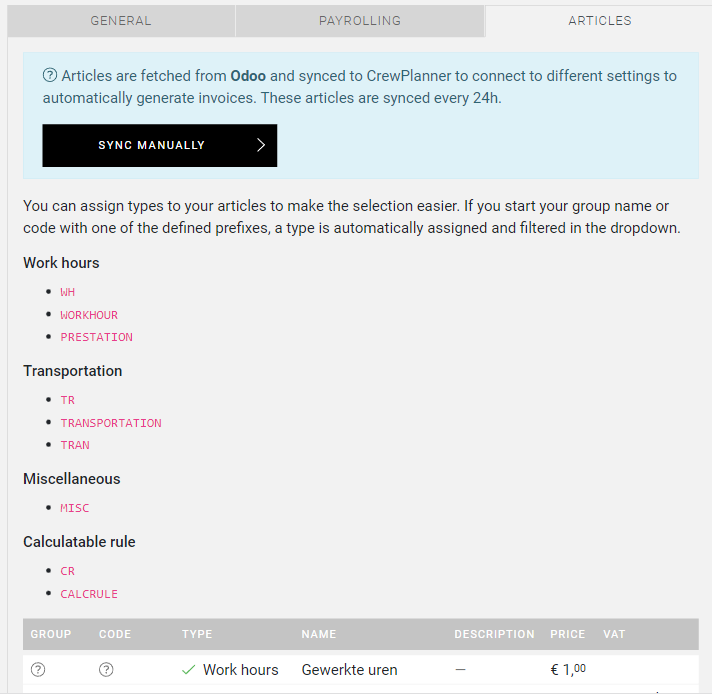
The articles you wish to use from Odoo can be divided into 4 types by adding a key piece of text to the Product Category field within the item under the section products and services in Odoo. These types are Work Hour, Transport, Miscellaneous and Calculable rule.
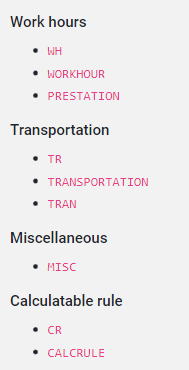
Each type has its own names that you can add to the code. You then place the pink text in front of the code name in Odoo followed by a “/” and then your name.
Here are a few examples:
WH / clerk
TR / car
MISC / rent walkie-talkie
Set articles in Odoo
In Odoo, you set up your items or Products, as they are called in Odoo, through the invoicing module.
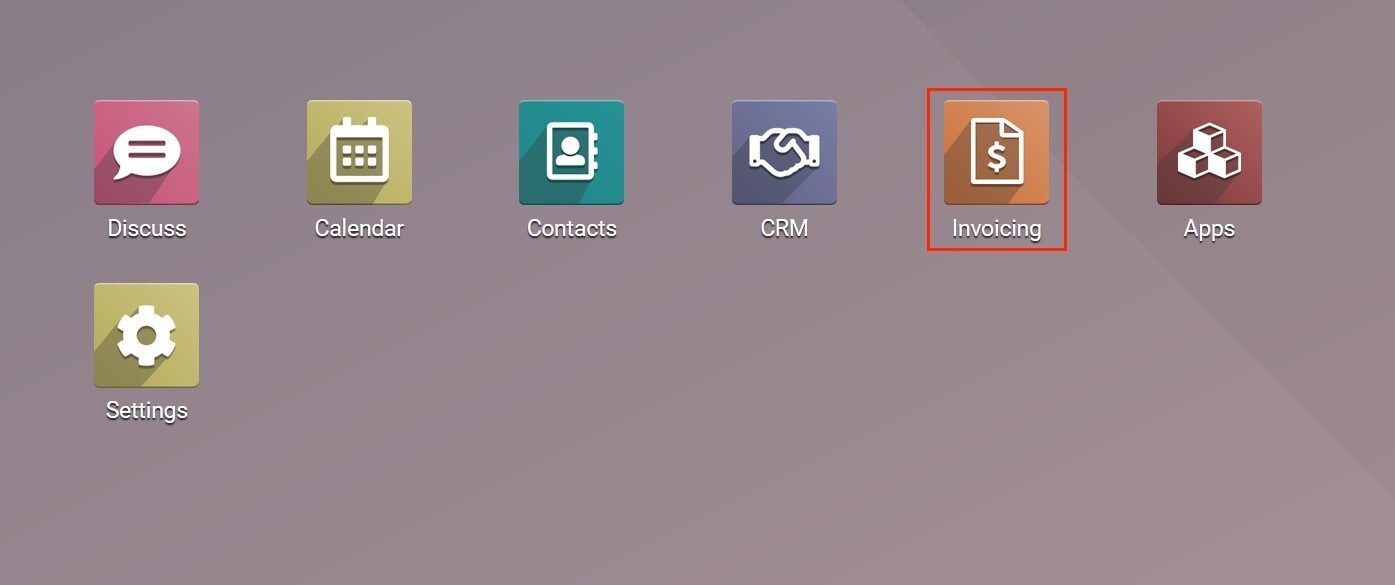
Then select Products from the dropdown menu under Customers:

On the next page, you can create your Products and via Product Category, link them to the items in CrewPlanner.
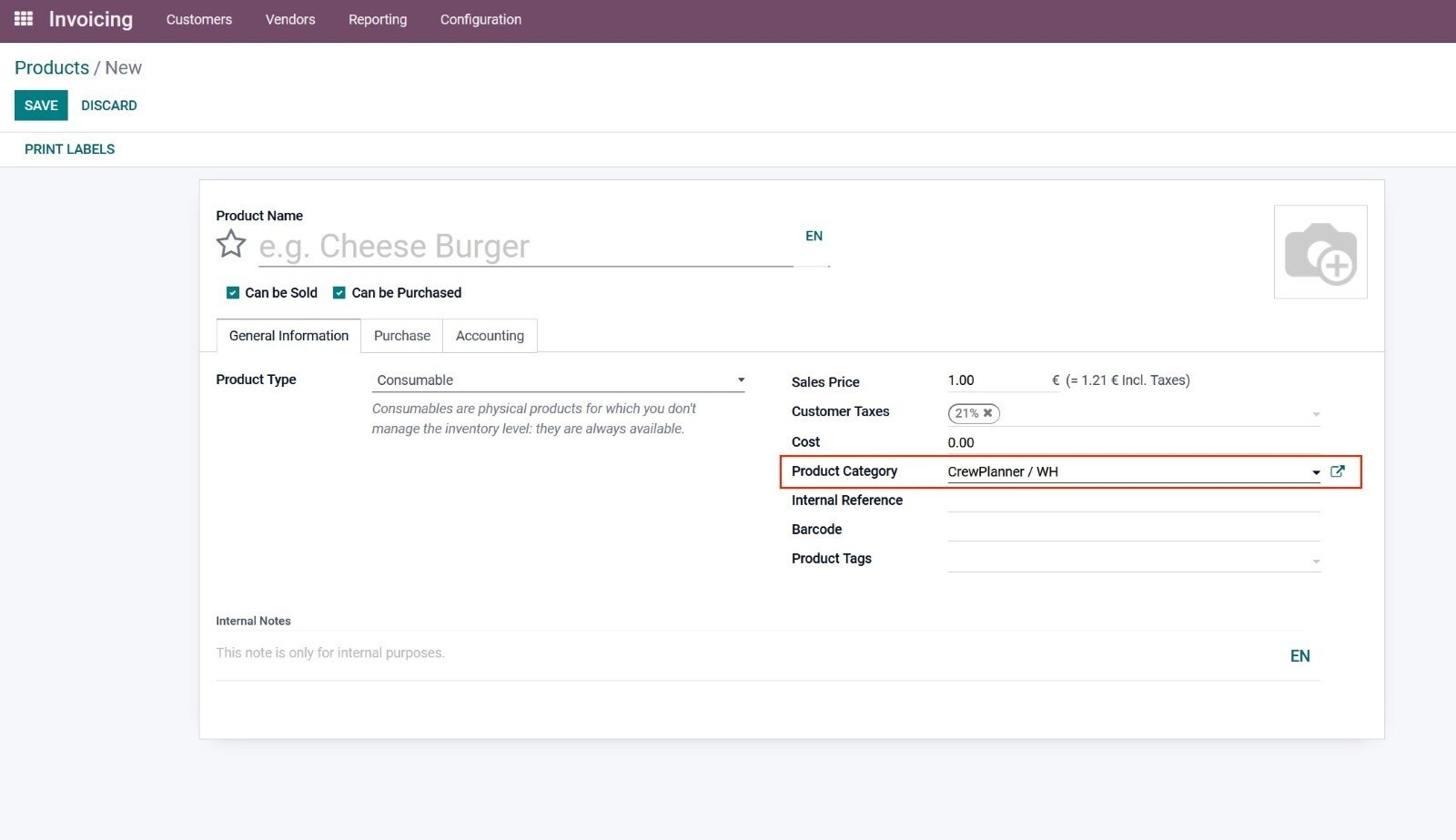
Once you select Product Category, the pop-up below opens where, using the codes, you link your Products to the items in CrewPlanner.

The sales price is always entered by CrewPlanner from the Shift Function settings and should be left EMPTY in Odoo. The only exception to this is for travel costs where you enter a price in the Odoo article. What we recommend is to enter a VAT code and set up the general ledger account.
Please note that the description or name of the article is visible to the customer on the invoice.
You have the flexibility to make this as comprehensive as you wish. It all depends on how you want to see this information reflected in your accounting analytics.
After you have set everything up, you must synchronize CrewPlanner to Odoo. By default, this happens once every 24 hours as standard. But you can also SYNC MANUALLY, this can be found at the top of CrewPlanner's ARTICLES page.
Connect ledger accounts with CrewPlanner
Finally, you have the option to connect your ledger accounts to your working hours and travel expenses by department, if you use this in CrewPlanner.
To set this up, navigate through SETTINGS to INVOICING, there you will find the tab LEDGER ACCOUNTS.

If you wish, you can set the ledger accounts per department for the work hours or travel expenses for your accounting analytics. As an example, this provides you with an overview of the turnover per department.
All the necessary links between CrewPlanner and Odoo have now been made and you are ready to set up your Invoicing Rules. You can find out how to do this using the article on our invoicing module, where we take you step-by-step through the various options. Here you will also find more information on how to create your invoices and credit notes.
We hope this article has helped you!
If you still have questions, take a look at our Crew Academy first. You might find the answer in one of our articles.